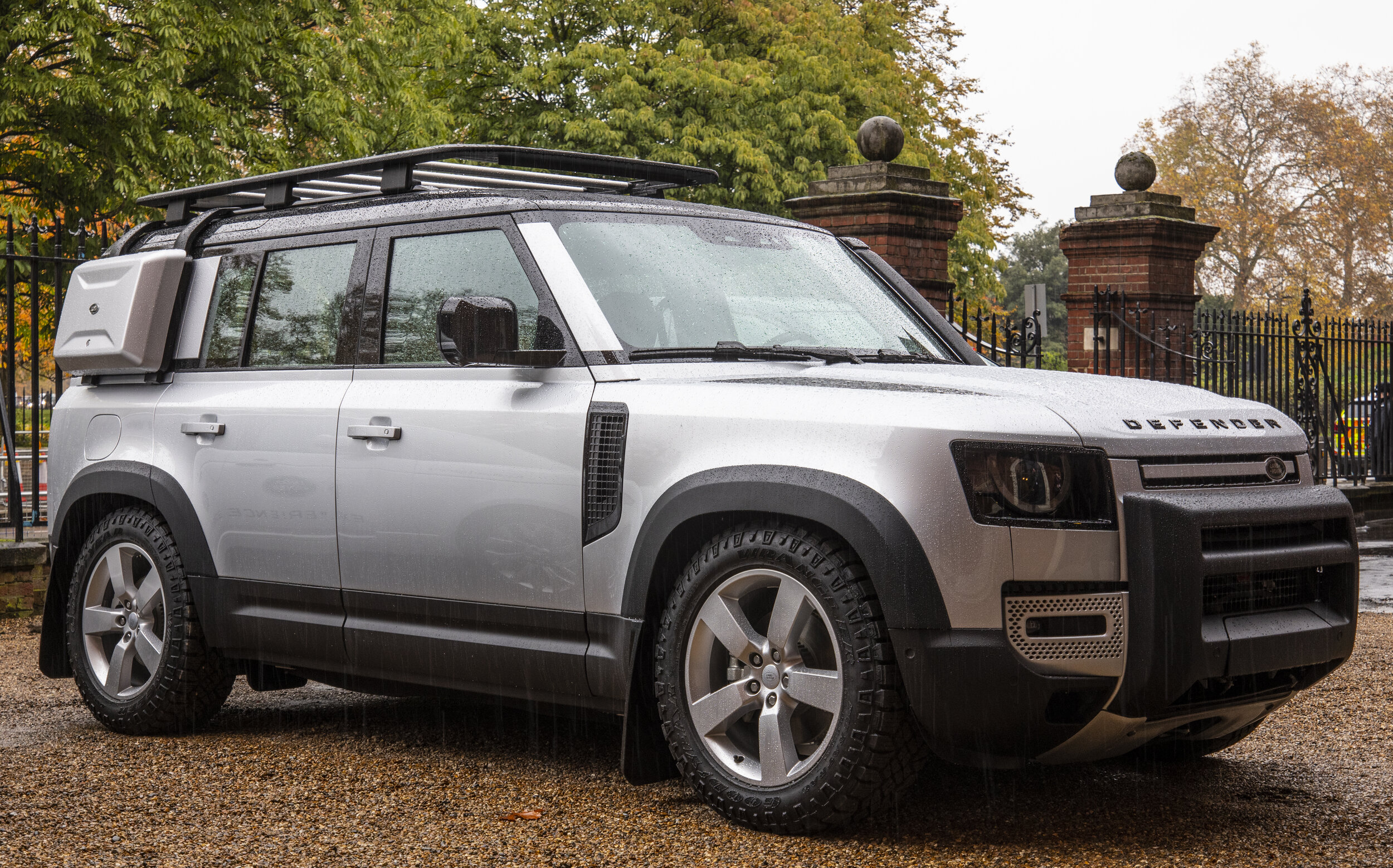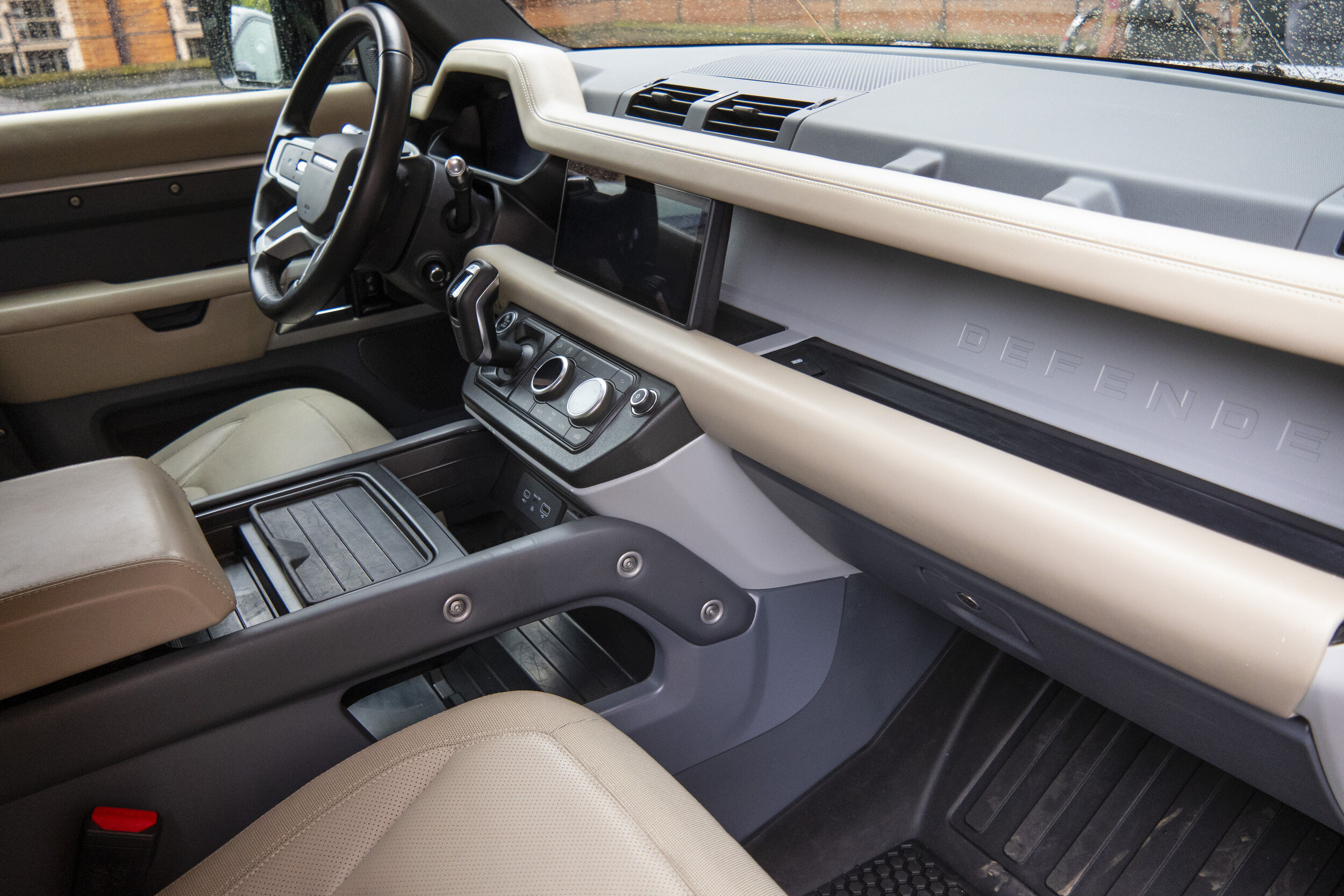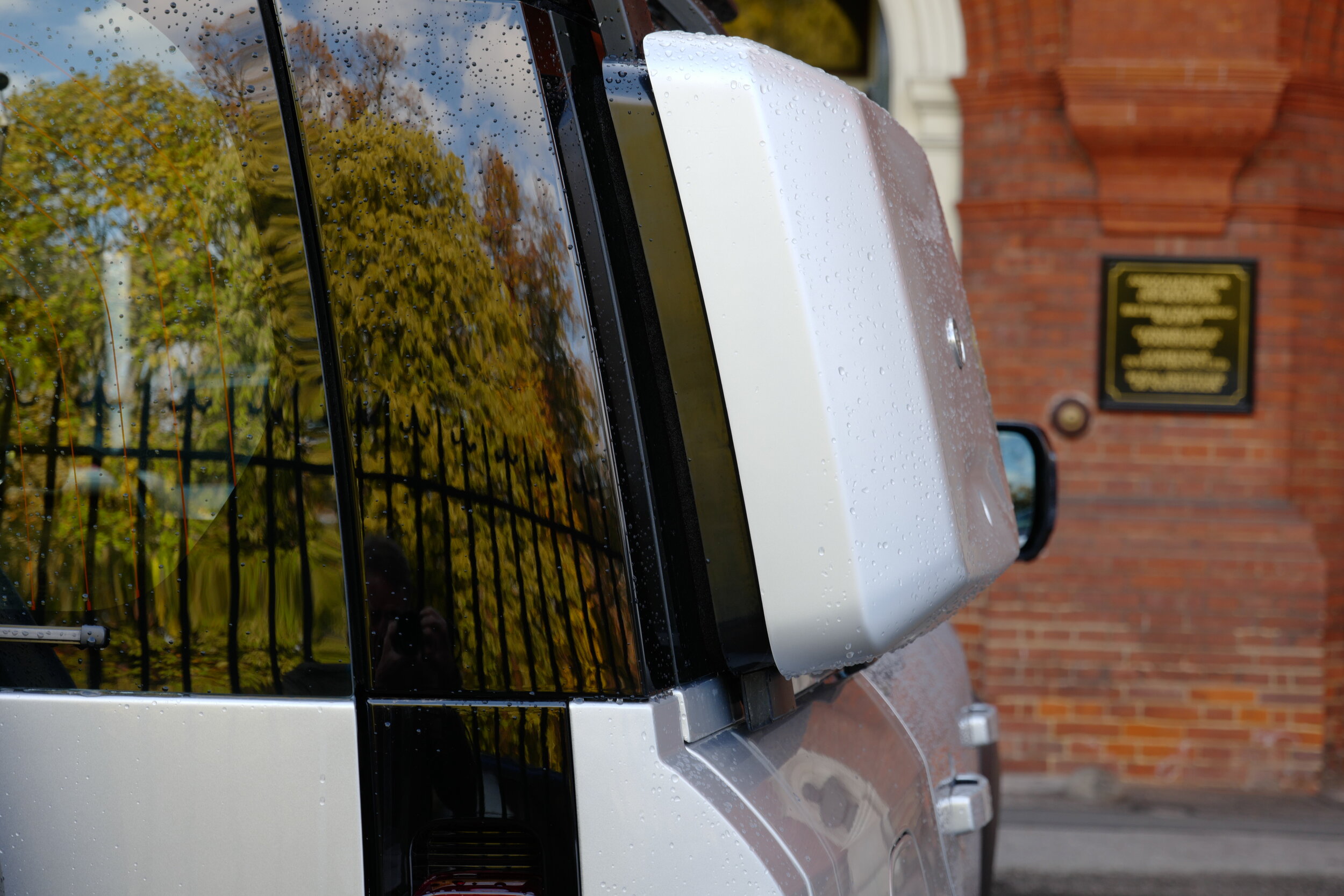A first hands-on-the-wheel look at the new Defender
The new Defender 110, snoozing at the bottom of its air-suspension travel.
I’m slowly—ever so slowly—creeping toward an actual driving session in the new Land Rover Defender. The latest step occurred in London, where Roseann and I were presenters at the Royal Geographical Society’s Explore event. Thanks to Land Rover’s Stephen Purvis, a still-not-quite-production 110 sat in the forecourt, accessible to us for photographing and sitting in except during the brief period it was strip-searched by a security detail looking for possible explosives prior to a scheduled passage of the Queen’s motorcade. (Any vehicle parked adjacent to that route for several days—even if it’s a new Defender at the RGS—is viewed with suspicion.)
While this one was still unavailable for driving, for the first time I was able to climb around in one, sit in the front and back seats, and get an eyes-on feel for the cargo area. Not to mention an eyes-on feel for the styling. More on that in a bit.
One’s first overwhelming visual impression of the new Defender 110 is of how much smaller it is than the “old” 110.
Except, it isn’t.
In every dimension except height the new model is larger than the old one—especially in length. Compare (dimensions in inches):
Overall length
Old: 184
New: 197
Wheelbase
Old: 110
New: 119
Width
Old: 78
New: 79
Height
Old: 80
New: 77 (Variable with air suspension)
If you’re familiar with the old Defender’s infamous and frequently painful lack of elbow room you might be concerned about the nearly identical width figures. However, the old Defender was widest at the mirrors; the new one is widest in the body. After sitting in the new one I can assure you that “Land Rover Elbow” will be an affliction of the past. There’s much more room—enough so that I simply didn’t notice the driver’s space; it just fit me comfortably with room to spare. In the old Defender—as comfortable as the seat itself was—I was always conscious of having to fit myself in between door, center console, steering wheel, and pedals. Not so in the new one. Legroom was generous for my 5’9”, and since I have no sympathy for tall people I didn’t check beyond that (it’s actually grown by several inches).
Note, too, the significantly longer wheelbase, despite the holdover wheelbase-oriented model designations. I guess JLR figured it would be too confusing to refer to the new models as the 119 and 101 (and the latter could be confused with the old Forward Control 101). I’ve not yet been able to find the length of the new 110’s rear cargo area with the seat down (it folds flat, hurrah!), but it’s long enough to lie down in, and, just as importantly, the layout is wonderfully rectangular, with none of the intrusions that mar the Wrangler Unlimited’s cargo bay. One of the huge strengths of the old 110 was the rectangular cargo area that made it so easy to slot in Wolf Packs or Pelican cases or even jerry cans if needed—or to fabricate custom cabinetry if desired. The new one looks close in this regard. Additionally, the floor is covered with a stout rubber matting, and the sill is level with the back gate opening for easy sweeping out of debris. There are four tie-downs, and a cargo rail is optional.
With the rear seats deployed, there is really good room for two or even three people behind front occupants with their seats adjusted comfortably. It’s an infinitely better arrangement than the old 110’s perch, which put an average person’s head level with the sheet metal above the doors. There is also an optional two-place third-row seat.
Back up to the front seat, and that dashboard—a coarse term for a work of art. Anchored by a crosswise beam structure of magnesium alloy, it incorporates two electronic displays—one in front of the steering wheel and one in the center of the dash. The presentation reminds me of nothing so much as a Series II dash brought into the 21st century. If that was the goal, the (American) designer succeeded brilliantly.
The center screen might be the first touch-screen display I’ve ever seen in any vehicle that actually looks like it belongs there, rather than resembling an iPad velcroed to the dash. Below the center screen is an abbreviated console containing the equally abbreviated shift lever, two blessedly manual dials for climate control, and several related buttons—along with a tiny button that is your entry to the low range of the Defender’s eight-speed automatic transmission, the only one offered. Now that you’ve choked on the idea of a Land Rover Defender without a manual transmission option, note too that those climate-control dials also operate the seat heaters . . . this truly is a new Land Rover Defender.
The driver’s electroluminescent display pops up a tachometer and speedometer when the engine is started, and—three, no four cheers for Land Rover—they are simple, round dials with white lettering on a black background. Perfect. The steering wheel incorporates too many buttons for my taste—hands-free phone controls, plus cruise control and, heh, the button for the steering-wheel heater. (One interesting observation from my press materials: The tachometer shows a redline of 6,800 rpm. Seriously? If that’s genuine I assume it is associated with the P400 straight-six, turbocharged mild-hybrid petrol engine, which boasts 395 hp. Wowsers.)
When Steve Purvis finally dragged me out of the driver’s seat so Roseann could have a look too, I went back to examining the exterior it terms of its promise as a legitimate overland machine.
Comparing approach, departure, and breakover angles, the old 110 is notably superior in approach angle but the new one wins in departure angle. Since the overall minimum on the new one (40º rear) is superior to the overall minimum on the old one (35º rear), I’d give the advantage to the new one. Breakover angle on the old vehicle is slightly superior. This is a function of the new 110’s longer wheelbase—which of course helps that departure angle.
Approach angle
Old: 49º
New: 38º
Departure angle
Old: 35º
New: 40º
Breakover angle
Old: 30º
New: 28º
While the Defender’s basic architecture is the D7 monocoque used in the Range Rover and Discovery, Land Rover claims it is 95 percent new and gives it its own designation, D7x (for, yes, “Extreme,” sigh . . . ). Among other advantages, the revised platform allows the body to be raised by 20mm to increase ground clearance. It is an exceptionally strong structure—torsional rigidity is 30,000 Nm/degree. No body-on-frame design can touch that. The downside, of course, is that the new Defender no longer has that Meccano Set construction suitable for complete disassembly with hand tools under a mango tree in Zambia.
I already knew about the Defender’s superb 900 mm (35.5-inch) fording depth, and the associated wizardry of the Wade Program, which adjusts the air suspension to its highest setting, locks the traction controls, switches ventilation to recirculating, indicates water depth on the center screen, and, finally, drags the brakes lightly for a few yards once clear of the water. This combined with the configurable Terrain Response will certainly help bolster Land Rover’s claim that the new Defender will be significantly more capable than the original.
So: What about that styling? In person the effect of any vehicle is different than it can ever be in photos or even video. Your eye simply takes in more in person than it ever can on a screen.
From the side I like the new Defender a lot—except for the incomprehensible body-color panel stuck in the middle of the greenhouse which, I pray, will be a deletable option. It garishly destroys the linear simplicity of the design, and I cannot imagine why it ever made it past a drunken sketch on a cocktail napkin, quickly rejected the next morning. “What was I thinking?” Of course, if the body-color panel hurts the lines, imagine what the body-colored Flintstones lunch box—sorry, “Gear Carrier”— stuck in the same spot does.
A component of both the “Adventure Pack” and the “Explorer Pack,” the box functions well to raise the drag coefficient while simultaneously lowering visibility out of one side mirror. Whether the trade-off is worth it to carry picnic supplies or (Graham?) a volcano kettle and tea-brewing kit will be decided by consumers, I guess. Here’s hoping some of the more useful components of the “Packs”—such as a built-in air compressor, a portable rinse system for muddy boots or dogs, a full-height cargo barrier, and an exquisitely integrated raised air intake—can be ordered a la carte.
Side view of the “commercial” version shows elegant simplicity . . . and more than a bit of evocation.
As to the front of the new Defender: I laugh every time I pass a Jeep Wrangler equipped with those scowling Angry Birds headlamp covers—and now Land Rover has gone and made the look standard. Urk. As to the rest, my chief befuddlement comes from the apparent lack of any really substantial change from the late and unlamented DC100 concept vehicle, which appeared in 2011 and was universally panned, and which Land Rover “disappeared” as quickly and brutally as Saudi Arabia does an embarrassing journalist. But, to me at least, the front of the new Defender resembles nothing so much as a DC100 Version 1.1. It could be mistaken for any number of Korean cute-utes, and—unlike the ascetic side profile—pays exactly zero homage to the old Defender. The version at the RGS had a large black rubber schnozzle which, in combination with the headlamps, my brain is still struggling mightily not to view as distinctly guppy-ish. ((Go back up and look at your peril.) From the driver’s seat (an important component of front-end “styling” in my book) visibility seemed quite good, although the rounded edges conceal the front corners more than the old Defender’s squared edges, which allowed one to gauge vehicle placement within centimeters. Inevitable to achieve the Defender’s astonishingly low .39 drag coefficient. (By comparison, the drag coefficient on my old Porsche 911SC was .40.)
I found myself with no strong opinions one way or the other on the rear styling, except for wishing that the spare tire had been mounted slightly to one side, as on its predecessor. I’m also not sure about the Mini Me pair of lamps in the fender beside each main cluster. At least one can see a bit of the old Defender’s profile in the “shoulder” just underneath the greenhouse, and from the side its flat back profile is familiar. (If chief design officer Gerry McGovern had used the term “verticality” one more time during his Frankfurt Motor Show intro talk I would have screamed.)
While I’m still ambivalent about some aspects of the Defender’s styling, I’m becoming more intrigued by the vehicle itself. I wasn’t among the poor souls who hoped futilely for a magically renewed old Defender with a 1948 frame design and solid axles; I figured from the start it would be a thoroughly modern, unibody, all-independent-suspension vehicle. Thus I was never disappointed in that regard. There are plenty of fans of the original who wish the company had let the name die rather than sully it on a “poseur” replacement. They’re the ones referring to the new vehicle as the “Pretender” or the “Offender.”
I understand nostalgia, and I certainly understand the loyalty commanded by the original Defender and the Series vehicles that preceded it. But you can stamp your feet and throw your toys out of the crib, or you can accept the reality that the current owners of JLR would have been stupid to consign the name Defender to a trophy case out of some honorable sense of history. Not going to happen. Likewise, given the vicissitudes of the marketplace and Land Rover’s up and down fortunes, the company was never going to go to the massive expense of engineering a ground-up replacement with a separate chassis and beam axles when they have monocoque architecture and plug-and-play all-independent suspension already available.
Is the new Defender going to be a competitor for Toyota’s mighty, body-on-frame, solid axle 70-Series Land Cruiser, or the stripped versions of the equally mighty Mercedes G-Wagen? No. Land Rover has ceded that market, possibly forever. We need to modify our expectations.
What I hoped for was a Defender that, while brought up to date with 21st century design and technology, would retain its suitability as a vehicle for long-distance exploration and rugged use—and, I’d might as well say this, would also be brought up to date with regards to the reliability of its competition. In the U.S., in terms of those in the market for an overlanding vehicle, I think that competition is going to be the 4Runner, the Pathfinder, the Jeep Rubicon Unlimited—even quad-cab versions of the Colorado, Tacoma, and Frontier.
I suspect a new Defender 110 will cost more than any of them, so that competition will be interesting to watch. The Defender, on paper at least, should be superior off-pavement to the 4Runner, the Pathfinder, and the pickups, and more sophisticated than the Wrangler (with a far higher payload). The big remaining question will be reliability—a question that will only be answered after users have put a few million miles under the wheels of the new “Pretender.”
And at that it was time to head back inside the august halls of the RGS.












